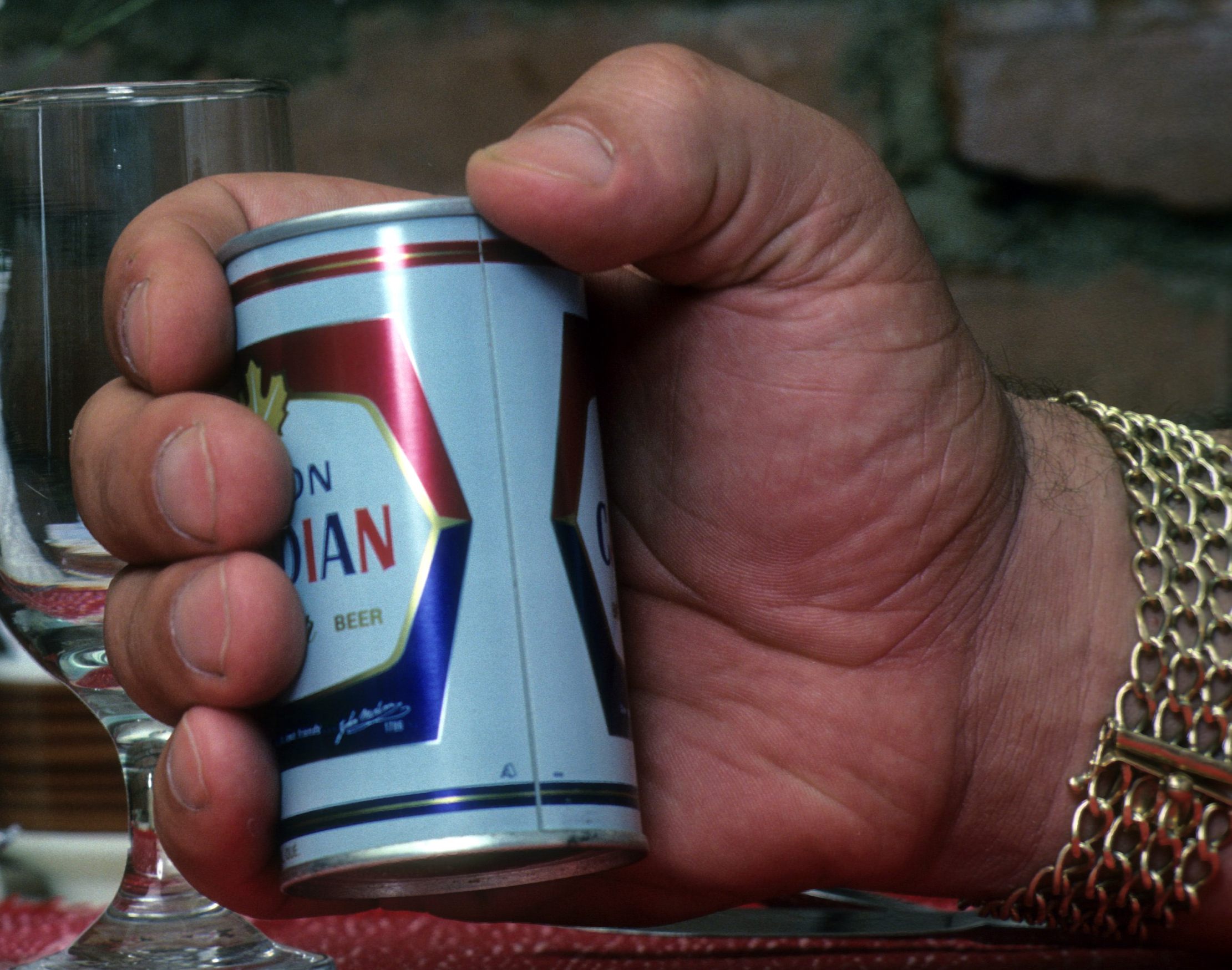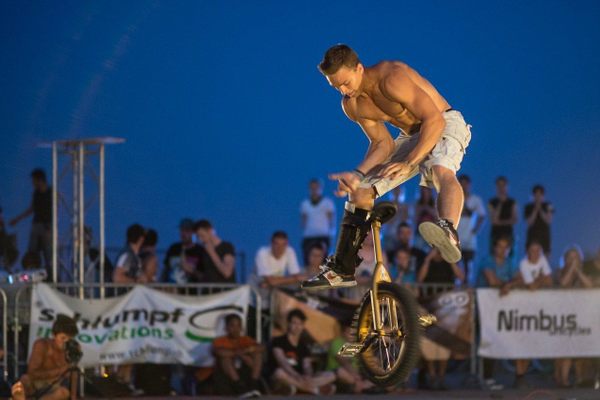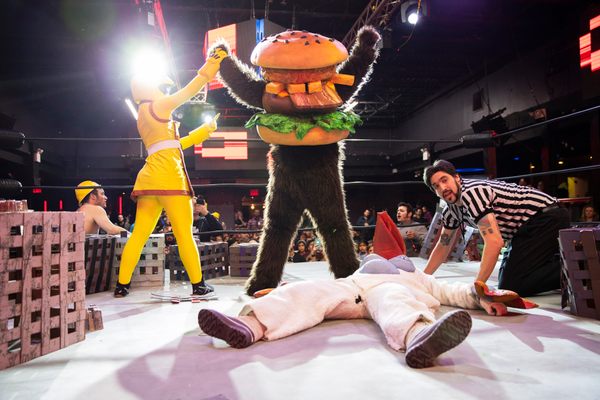The Story Behind the Famous Portrait of André the Giant Clutching a Beer Can
André the Giant holds a 12-oz can of Molsons beer. He is positioned next to the photographer in the wrestler’s own cafe. It was shot for a 1981 issue of Sports Ilustrated. (Photo: Sports Illustrated Classic/Getty Images)
This is part of an occasional series called Camera Obscura, a deep dive into a photograph that is seemingly inexplicable. If you have any suggestions for future stories, send them to pitches@atlasobscura.com.
There are 42 half- or full-page ads in the December 21, 1981 issue of Sports Illustrated, and 29 of them are for alcohol or cigarettes. But that two page photo spread featuring what appears to be a new miniature version of the Molson beer can? It’s not an ad at all. It’s the opening image to an amazing story about one of the largest characters the world has ever known: André Roussimoff, aka André the Giant.

The resulting photo makes the beer look so comically small that when the out-of-context image made the rounds on Reddit and Buzzfeed three decades later, many commenters insisted that it must have been a product of Photoshop. But Photoshop didn’t exist until six years after the photo first appeared in Sports Illustrated and more importantly, Roussimoff’s hand was actually that big. The writer who penned the piece, Terry Todd, noted that Roussimoff’s wrists are more than a foot in circumference—“about average for an adult male western lowland gorilla”—and that you can pass a silver dollar through his ring, which would make it around a size 30. In the accompanying 8,000 word article, “To the Giant among Us”, Todd takes the reader on a rollicking journey with the amiable Roussimoff from New York to Montreal, where they finally end up in the wrestler’s own French cafe, Le Pitcher. There’s a photo of Muhammad Ali holding Roussimoff’s fist up next to his face; they’re roughly the same size.
While the iconic image might seem obvious now—and carries significance for Roussimoff outside of the realm of the posed picture—the beer was not the first thing the wrestler held. Once the group arrived at the photo shoot, the photographer Stephen Green-Armytage struggled to find an object that would to properly show off Roussimoff’s proportions. “Obviously we chose an item whose size is familiar to the magazine’s readers,” he told me. “I also photographed André with the restaurant manager, and although the giant towered over him, the reader would not know if he was a particularly small man or of normal size.” Another photo with the wrestler posing with Central Park horse also proved unsatisfying—“one wouldn’t know if it was a pony or a Clydesdale.” So when Todd suggested the beer-centric staging, Green-Armytage put aside his worry that the photo would be mistaken for an ad and snapped away.
After all, while everyone’s hands are different, a 12-ounce beer, he noted, is always the same size.
 A close-up of the famous shot.
A close-up of the famous shot.
Green-Armytage and Todd were by no means the first to fixate on Roussimoff’s appendages. Andre’s father’s first words upon meeting his son were, “Such hands.” Roussimoff was born in rural France to normal-sized parents Boris and Mariann, and his gigantism, caused by extra growth hormone from a pituitary tumor, was evident from birth. By age 11, André was said to be 6’3” and more than 200 pounds. He eventually grew to be 7’4”, but his height wasn’t the most remarkable thing—there are dozens of people in the world taller than him. Instead it was his incredible bone density and muscle tone. Without the help of much extra body fat, Roussimoff often weighed in at more than 500 pounds, and was incredibly strong and athletic. Before he became a professional wrestler, he was a dominating rugby player.
The Sports Illustrated article focused on his wrestling career. During the late 1970s and early 1980s, he was the main attraction in the rapidly growing World Wide Wrestling Federation; the charismatic showman went 15 years without ever “losing” a match. The WWWF’s owner, Vincent McMahon Sr., commissioned a custom-made vehicle to carry his star in comfort to matches all over the Northeast. As Todd writes in the article, this means that McMahon “bought a heavy-duty van, had the ceiling raised about a foot and installed an oversized couch.”
Todd joined Roussimoff in the van for much of the article, and it’s quite the ride, as Todd regales readers with stories of Rousimoff’s incredible appetite and energy. Todd was an inspired choice to write the piece. A former national champion powerlifter, he was a large man himself at 6’2”, 335 pounds; that’s his huge-though-diminished hand holding the glass in the top image. (At one point, Todd could squat more than 700 pounds and bench press more than 500 pounds.) When he pitched the story idea to Sports Illustrated, he emphasized his access. After all, many fellow powerlifters had become wrestlers and promoters, and one of them was willing to vouch for him to McMahon.
As a result of his background, Todd’s fascinated by Rousimoff’s capabilities, and can’t help but imagine what the giant (or “Brobdingnagian Frenchman” as he refers to him) could do if he really started training for power. Todd quotes a record-holding weightlifter who says, “I honestly believe that if André took a couple of years away from the game to train like the top lifters do, and if he developed a close personal relationship with his friendly neighborhood pharmacist, the world powerlifting records in both the squat and the deadlift would fall.”
The story quickly diverts from talk of hypothetical steroid use, though, to Roussimoff’s actual chemical vice: alcohol. His capacity for booze was amazing. Modern Drunkard magazine (what, you don’t subscribe?) claims that no other human has ever matched Roussimoff as a drinker. His most amazing (if lightly sourced) feat? The time he chugged 119 beers in six hours, a pace of roughly a beer every three minutes.
Todd doesn’t witness that level of debauchery, but what he does see is impressive enough. “During the week or so I was with him,” he wrote, “his average daily consumption was a case or so of beer; a total of two bottles of wine, generally French, with his meals; six or eight shots of brandy, usually Courvoisier or Napoléon, though sometimes Calvados; half a dozen standard mixed drinks, such as Bloody Marys or Screwdrivers; and the odd glass of Pernod.” That adds up to roughly 7,000 calories a day in alcohol alone. Green-Armytage wryly notes that beer was an appropriate subject for the image, “since he drank a lot of it, and had tremendous capacity.”
Oddly enough, though, Roussimoff never once seems drunk to Todd, and instead uses his hours of drinking time each day to chat with his ever-growing circle of friends and fans. Todd was among them. When Roussimoff died 12 years after the article appeared, at the young age of 46, from congestive heart failure likely related to his gigantism, Todd spoke at his memorial service. By then, Roussimoff had endeared himself to the next generation of fans with his role of Fezzik the gentle rhyming giant in the movie The Princess Bride. Roussimoff knew his life was likely to be shorter than most. “If I were to die tomorrow,” he said in the article, “I know I have eaten more good food, drunk more beer and fine wine, had more friends and seen more of the world than most men ever will.”











Follow us on Twitter to get the latest on the world's hidden wonders.
Like us on Facebook to get the latest on the world's hidden wonders.
Follow us on Twitter Like us on Facebook